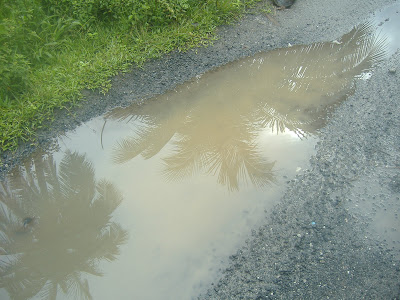 As I continue this process of reflecting on my final days, memories and experiences from Samoa, I thought it would be fun to look back at what I thought were the best pictures from my time in the Peace Corps. The process of taking a picture happens in an instant, but the enjoyment of looking at them can last a lifetime.
As I continue this process of reflecting on my final days, memories and experiences from Samoa, I thought it would be fun to look back at what I thought were the best pictures from my time in the Peace Corps. The process of taking a picture happens in an instant, but the enjoyment of looking at them can last a lifetime. During my two years in Samoa, I tried hard to capture the unique moments, the frustrating moments, and the joyous moments. However, I am fully aware that so many of them were lost in the blink of an eye, when the shutter lens was closed, and the camera powered down. Only if the camera had been with me at every minute, would I have been able to capture a more complete view of the culture, people, and places. But maybe it’s better this way, to have a piece of the puzzle missing, for that challenges me to recall, revisit, and reflect on those moments when the camera wasn’t around, when it was just me, living the life and loving the moment.
Editor's Note: After looking through the pictures, feel free to vote on your favorite picture! All you have to do is go to the right side column of this screen in the blue box, below my profile picture, and select your choice. The pictures are labeled above with the number of that picture. Thanks for your opinions!
Picture #1

Dreaming about the future. Walking through the village one evening, I found all these boys sitting by the ocean's edge, looking out over its open waters--2011
Picture #2

A culture and the test of time. A matai (high chief) from my village, during one of their weekly meetings--August 2011
Picture #3

Mighty force. Village members playing volleyball, seem oblivious to the waves crashing from passing Cyclone Wilma--January 2011
Picture #4

A breakfast for champions. This is what I woke up to in my room one morning--2009
Picture #5

Whatever it takes to get the job done! Here Alofa is working to remove pins in the library walls before painting--2010
Picture #6

It doesn't quite fit. A cow leg protrudes out of a freezer in the church hall--January 2011
Picture #7

Life in the slow lane. Here I am taking the long walk from the main road, back to my village on a day when the bus wasn't running--July 2010
Picture #8

Creativity at work! I had gone out jogging and when I got back, Saulo had left this behind, to inform me I had missed his visit--2011.
Picture #9

Simply Samoa. The view looking out over the water along the road to my house.
Picture #10

Chicka Chicka Boom Boom! During our group's Close of Service Conference, it was actually my idea that we all climb this coconut tree for our final photo together--September 2011
Picture #11

The Ringmaster. Milo was all dressed up and ready for Sunday church service--2010
Picture #12

Under the surface. Here I was snorkeling for the first time in Samoa--October 2009
Picture #13

The sweet spot. On one of my early days in the village when I was still very homesick, I walked up to this vantage point along the road and felt such a feeling of empowerment as I thought about the vastness of the ocean before me--2010
Picture #14

Love thy neighbor. In the Samoan culture, you look out for your neighbor, and in this case, those without a chair--2010
Picture #15

The love of learning & teaching. Here Christopher gets ready to ask me a question as I'm still helping someone across the room--October 2011
Picture #16

Keep on hanging on. Climbing a steep and slippery rock face--July 2010
Picture #17

Home is where the heart is. My heart wasn't here in the beginning, but eventually it found and made a home--one that will be a part of me forever.
Picture #18

Heal the World. Students prepare to sing and dance to Michael Jackson's "Heal the World"--November 2011
Picture #19

The expedition. For the first time in his life, a matai from my village heads up the mountain he has lived next to since he was born--June 2011
Picture #20

Friendship. Neueli and Saulo embrace for a picture during a field day at school--May 2010
Picture #21

Catch of the day. My neighbor had caught all of these beautiful fish using a spear, in two hours time--2011
Picture #22

The force of gravity. Spectacular Fuipisia Waterfall on the island of Upolu--July 2010
Picture #23

All dressed up with nowhere to go. In the training village, each of our host families put us in outfits before the village wide dance--2009
Picture #24

The break of day. Sunrise on Easter Sunday--April 24, 2011
Picture #25

Friendships made. Here I am with Saulo's family, who I grew very close to--November 2011
Picture #26

Heavy lifting. Logi may be short, but he's able to get the work done.
Picture #27

Moonlight hidden. Out for an evening run under the light of the full moon, I was able to grab this shot--2011
Picture #28

Blue Lagoon. Flying over Samoa's lagoons on the way to American Samoa--September 2011



























